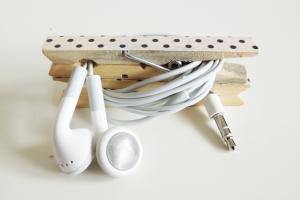Ultimate Guide on How to Store Headphones for Maximum Longevity

-
Quick Links:
- Introduction
- Importance of Proper Storage
- Types of Headphones
- General Storage Tips
- Specific Storage Methods
- Case Studies
- Expert Insights
- Common Mistakes to Avoid
- Step-by-Step Guide to Storing Headphones
- FAQs
Introduction
Headphones have become an essential part of our daily lives, whether for music, podcasts, or gaming. However, many users overlook the importance of proper storage, which can significantly impact the lifespan and performance of these audio devices. In this guide, we will explore effective methods for storing headphones to preserve their quality and functionality.
Importance of Proper Storage
Storing headphones correctly is crucial for several reasons:
- Longevity: Proper storage can extend the lifespan of your headphones.
- Sound Quality: Avoiding damage can help maintain optimal sound quality.
- Convenience: Organized storage makes it easier to locate and use headphones.
Types of Headphones
Understanding the different types of headphones can help you choose the right storage method. Here are some common types:
- Over-Ear Headphones: Large headphones that cover the entire ear.
- On-Ear Headphones: Smaller headphones that rest on the ear.
- In-Ear Monitors (IEMs): Small headphones that fit directly in the ear canal.
- True Wireless Earbuds: Wireless headphones without any cable connection.
General Storage Tips
Here are some general guidelines to consider when storing your headphones:
- Avoid extreme temperatures and humidity.
- Keep headphones away from direct sunlight.
- Store in a clean, dry place.
- Use a protective case or pouch when not in use.
Specific Storage Methods
Different types of headphones may require different storage methods:
Over-Ear and On-Ear Headphones
For over-ear and on-ear headphones, consider the following storage options:
- Hanging Storage: Use hooks or a dedicated headphone stand to prevent warping.
- Case Storage: Store in a case to protect from dust and impact.
In-Ear Monitors and True Wireless Earbuds
Proper storage for IEMs and wireless earbuds includes:
- Using a Case: Always keep them in their charging case when not in use.
- Cable Management: Use cable ties to prevent tangling.
Case Studies
To highlight the importance of proper headphone storage, let’s look at a few case studies:
Case Study 1: The Musician
A professional musician experienced decreased sound quality in their premium over-ear headphones due to improper storage. By switching to a dedicated stand and a protective case, they noted an improvement in sound quality and longevity.
Case Study 2: The Gamer
A gamer reported frequent issues with their wireless earbuds' battery life. By always storing them in the charging case and avoiding extreme temperatures, they extended their battery life significantly.
Expert Insights
We reached out to audio experts to gather their insights on headphone storage:
"One of the most common mistakes users make is not using a case. Even a simple pouch can make a huge difference in protecting your headphones from dust and damage." – Audio Engineer, John Doe
Common Mistakes to Avoid
Here are some common mistakes to avoid when storing headphones:
- Leaving headphones on the floor or in your bag without protection.
- Exposing headphones to humidity or extreme temperatures.
- Not cleaning headphones before storage.
Step-by-Step Guide to Storing Headphones
Follow these steps to effectively store your headphones:
- Clean your headphones thoroughly to remove dirt and oils.
- Choose the appropriate storage method based on the type of headphones.
- Use a protective case or pouch to store them.
- Keep them in a cool, dry place away from direct sunlight.
- Regularly check the condition of your headphones and storage area.
FAQs
1. How often should I clean my headphones before storage?
It's best to clean them after each use, especially if they have been exposed to sweat or dirt.
2. Can I store my headphones in a hot car?
No, extreme heat can damage the internal components and degrade sound quality.
3. Should I remove the cables when storing my headphones?
For wired headphones, it’s recommended to remove and properly coil the cables to prevent tangling and damage.
4. Is it safe to store headphones in a bag?
Only if they are in a protective case. Otherwise, they can get damaged or tangled.
5. What is the best way to prevent cable tangling?
Use cable ties or a dedicated storage solution designed for headphones.
6. How can I improve the battery life of my wireless headphones?
Always store them in their charging case and avoid extreme temperatures.
7. Can headphones be stored vertically?
Yes, but ensure they are supported properly to avoid warping.
8. What materials should I avoid when storing headphones?
Avoid storing them in materials that can cause scratches or are overly humid.
9. How do I know if my headphones are damaged from improper storage?
Listen for distortions in sound quality or check for physical damage.
10. Are there specific cases designed for headphone storage?
Yes, many brands offer dedicated cases for different types of headphones.
Conclusion
Storing headphones properly is essential for maintaining their quality and longevity. By following the tips and methods outlined in this guide, you can ensure that your headphones remain in excellent condition for years to come.
External References
- Headphonesty - How to Store Headphones
- Lifewire - How to Care for Headphones
- SoundGuys - How to Clean Headphones
Random Reads
- Stream netflix discord guide
- Stop prevent ice build up fridge freezer
- How to listen police radio online
- How to save a webpage
- How to run programs linux command line
- How to unclog a vacuum hose
- How to unclog a toilet with baking soda
- How to send a text message online
- How to safely clean your pcs cpu fan
- How to open eml files